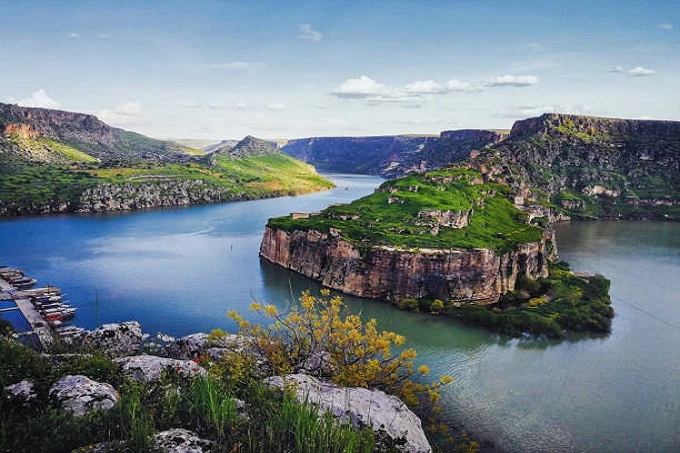A discontinuous rocky ledge can be found in the south of modern Turkey, on the banks of the Euphrates River. This location was once home to an Assyrian citadel in periods long past. After some time had passed, the Byzantines constructed a powerful fortress on top of its remains. They referred to it as Rumkale, meaning “a Roman castle”. After some time had passed, the Crusaders gave the region the name Rankulat. Keep reading this article to discover what is carefully hidden from human eyes in the mysterious impregnable fortress with an incredibly ancient paradoxical past.
Fortress with a rich history
The history of the fortress dates back hundreds of years. This cape’s exceptional strategic location has traditionally been one of its most valuable assets. On it can be found the remnants of many ancient settlements, the ages of which are quite difficult to ascertain. Researchers have uncovered the remains of fortifications from multiple periods, including Assyrian, Hellenistic, Roman, and Byzantine. The Merziman River flows into the renowned Euphrates. As a result of the construction of the Birecik Dam on the Euphrates in the year 2000, the region was partially submerged in water. The formidable walls have been retained in remarkably good condition. The most plausible explanation for this is that the only way to reach here from the cities of Zeugma and Halfeti that are located nearby is by boat.
Biblical past of Rumkale
Some historians claim that the proto-Hittites founded the city of Rumkale in 1230 B.C. Others are certain that this took place in the year 855 BC under the reign of the Assyrian king Shalmaneser. Both of these groups, as well as others, acknowledge that both of these possibilities are possible. Historically, the Hittites, the Assyrians, the Medes, the Persians, the Macedonians, and the Seleucids and Parthians owned this region. After that, the Romans arrived. According to the story, the Apostle John once lived in a cave carved into the rock. It was in this location that he copied the Holy Scriptures. Many experts agree that one of these Bibles is hidden in Rumkale.
Muslim past
At the beginning of the Middle Ages, the land underwent several different ownership changes. Initially, it was owned by Muslims, but later it was taken over by Armenians, Mongols, and Crusaders. In the end, the Armenian rulers made a deal with the County of Edessa to purchase the fortress. The fortress was reconstructed entirely, enlarged, and fortified to the point that it is now nearly impossible to take. Before the Mamluks took control of the region in 1293, this place was home to the Catholicos, who served as the leader of the Armenian Church. When they took it over, the new Muslim proprietors gave the fortress the name Qal’at- al-Muslimin. It took the attackers three days to take control of the bastion that was heavily guarded. Before the fortress could finally be taken, they had to set up more than three dozen catapults.
This place was known as one of the main medieval scriptoriums during the Armenian period. Some of that time’s best illustrators and scribes worked here, including the famous Toros Roslin. In 1516 Rumkale was captured by the Ottoman Empire, and the fortress was turned into an impregnable prison. Everyone who was considered dangerous for the state and the Sultan personally was sent here. With such remoteness and inaccessibility, political criminals and opponents of the authorities no longer posed any threat.
Famous historians about Rumkale
Rumkale persisted in this condition until Richard Pocock, an English writer, visited it in 1737. The fortress steadily deteriorated over a century before being fully abandoned. In 1838, Helmuth von Moltke went to the location. “In Rumkale, it is difficult to identify where the rock ends and the work of human hands begins,” he said when describing his impressions. The Euphrates River and the waters of the Marsifan Stream both encircle the mountain’s ledge on either side. The cliff’s height ranges from 12 to 30 meters in various locations. Battlements and fortifications with tiny openings dug into them crown the rocks. You must climb over roughly six ledges to enter the impenetrable fortress. They appear to have been constructed by humans, yet their origins are natural.
Another traveller, Karl Ritter, wrote at the end of the 19th century that the once beautiful fortress was in ruins. Huge columns of buildings were toppled. Magnificent architectural creations lie on the ground in an unsightly pile of stones. Only the majestic proud walls that the Romans erected have survived. There is an Armenian well inside the fortress, and its depth reaches two hundred meters. In its splendour, it is comparable to the creations of the Romans. The vaults of the well are wide enough for a spiral staircase to descend to the level of the waters of the Euphrates River. Mules were climbing up it, carrying water.
However, most of the bottom portion of the castle was wrecked in 2000 when the Birecik Dam was constructed and filled with water. Several Armenian churches and monasteries, as well as water tanks, fountains, and moats, are examples of architecture that have been preserved and may still be seen today. In addition, there is a palace that dates back to the Ottoman period and the ruins of residential buildings in the northern section of the site. The ancient buildings that have been preserved date back to the 12th century.
